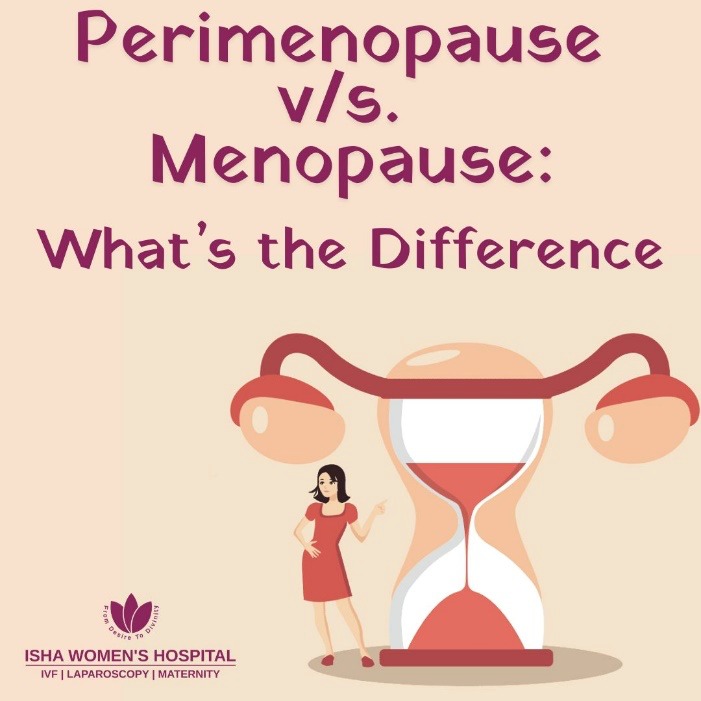Perimenopause vs. Menopause: What’s the Difference?

What Is Perimenopause?
When Does It Start?
Key Changes and Symptoms:
- Irregular periods: Menstrual cycles may become shorter or longer, lighter or heavier.
- Mood swings: Fluctuating hormone levels can lead to irritability, anxiety, or depression.
- Sleep disturbances: Difficulty falling or staying asleep is common.
- Hot flashes and night sweats: Sudden feelings of warmth, often accompanied by sweating, especially at night.
What Is Menopause?
Average Age: In most women, menopause occurs naturally between the ages of 45 and 55, with the average age being around 51 years.
What Happens After Menopause?
Once menopause is complete, a woman enters the postmenopausal stage. Estrogen levels remain consistently low, and while menstruation has stopped, some symptoms like hot flashes or vaginal dryness may continue.
Key Differences Between Perimenopause & Menopause
- Definition: Transition phase leading up to menopause
- Hormonal Changes: Fluctuating estrogen and progesterone levels
- Symptoms: Irregular periods, mood swings, night sweats
- Duration: Can last between 4 to 10 years
- Definition: Occurs after 12 consecutive months without a period
- Hormonal Changes: Significant drop in estrogen levels
- Symptoms: Hot flashes, vaginal dryness, bone loss
- Duration: Permanent stage (followed by post-menopause)
Symptoms & Causes of Perimenopause and Menopause
Common Symptoms of Perimenopause
Perimenopause is often marked by unpredictable hormone changes, which can cause a variety of physical and emotional symptoms:
- Irregular Periods: Menstrual cycles may become inconsistent — periods can be shorter, longer, heavier, or lighter than usual.
- Mood Swings & Irritability: Fluctuating hormones can lead to emotional ups and downs, including increased anxiety, sadness, or irritability.
- Hot Flashes & Night Sweats: A sudden feeling of warmth, often followed by sweating and a flushed face or chest. Night sweats may interfere with sleep quality.
- Fatigue & Brain Fog: Many women report low energy, poor concentration, and difficulty remembering things during this time.
Once menopause is reached, some symptoms from perimenopause may continue or evolve:
- No Periods for 12+ Months: This is the defining sign of menopause — the end of monthly cycles.
- Vaginal Dryness & Discomfort: Due to reduced estrogen, many women experience dryness, itching, or pain during intercourse.
- Bone Density Loss: Estrogen helps maintain bone strength. Its decline can lead to osteopenia or osteoporosis, increasing fracture risk.
- Metabolism Slowdown & Weight Gain: A slower metabolism, combined with hormonal shifts, often leads to increased abdominal fat and difficulty losing weight.
While both phases are a natural part of aging, several underlying factors contribute to their onset:
Natural Aging Process
- The primary cause is the gradual decline of estrogen and progesterone production by the ovaries.
- Ovulation becomes irregular, eventually stopping altogether.
- Surgical removal of ovaries or hysterectomy can trigger immediate menopause.
- Chemotherapy or radiation therapy may also damage ovarian function.
- Certain autoimmune disorders can impact hormone regulation and accelerate menopause.
- High stress, smoking, poor nutrition, and lack of exercise can cause earlier onset or worsen symptoms.
- Maintaining a healthy lifestyle may help ease the transition and delay premature menopause.
Managing Symptoms & Treatments
Natural Remedies for Perimenopause & Menopause and Medical Treatments for Severe Symptoms
Making small changes in your lifestyle can go a long way in easing symptoms.
1. Balanced Diet & Nutrition
- Calcium & Vitamin D: Strengthen bones and reduce the risk of osteoporosis.
- Phytoestrogens: Found in soy, flaxseeds, and legumes — they mimic estrogen and support hormone balance.
- Strength Training: Helps preserve muscle and prevents bone loss.
- Cardio Workouts: Improve heart health, boost mood, and help manage weight gain during menopause.
- Yoga, Meditation, & Deep Breathing: Effective in reducing anxiety and mood swings.
- Sleep Aids: Melatonin supplements and herbal teas like chamomile may enhance sleep quality naturally.
When natural remedies aren’t enough, medical treatments can bring relief.
1. Hormone Replacement Therapy (HRT)
- HRT replaces declining hormones to relieve hot flashes, night sweats, and prevent bone loss.
- HRT is not for everyone — consult a specialist to see if it’s right for you.
- SSRIs and antidepressants help ease mood swings, anxiety, and depression.
- Osteoporosis medications like bisphosphonates can strengthen bones and reduce fracture risk.
- Low-dose estrogen creams, rings, or tablets treat vaginal dryness and discomfort without affecting the whole body.
When to See a Doctor for Menopause Symptoms
- Severe hot flashes or night sweats that interfere with sleep or work.
- Extreme mood changes, persistent sadness, or anxiety that affects your quality of life.
- Pain during intercourse, vaginal dryness, or recurrent infections.
- Signs of osteoporosis, such as frequent fractures or bone pain.
Don’t wait for symptoms to take over your life. Take charge of your health today — because you deserve to feel your best, every day.
Frequently Asked Questions (FAQs)
Ans - Most women enter perimenopause in their mid-to-late 40s, but it can start earlier.
2. How do I know if I’m in perimenopause or menopause?
Ans - If you still get irregular periods, you’re in perimenopause. If no periods for 12 months, you’re in menopause.
3. Can perimenopause symptoms be treated naturally?
Ans - Yes! Healthy diet, exercise, and stress management can help reduce symptoms.
4. Is menopause the end of symptoms?
Ans - Not always. Hot flashes, vaginal dryness, and sleep issues may continue into post-menopause.
5. Should I take hormone therapy for menopause?
Ans - It depends. HRT helps with severe symptoms but isn’t suitable for everyone (especially with a history of breast cancer).
